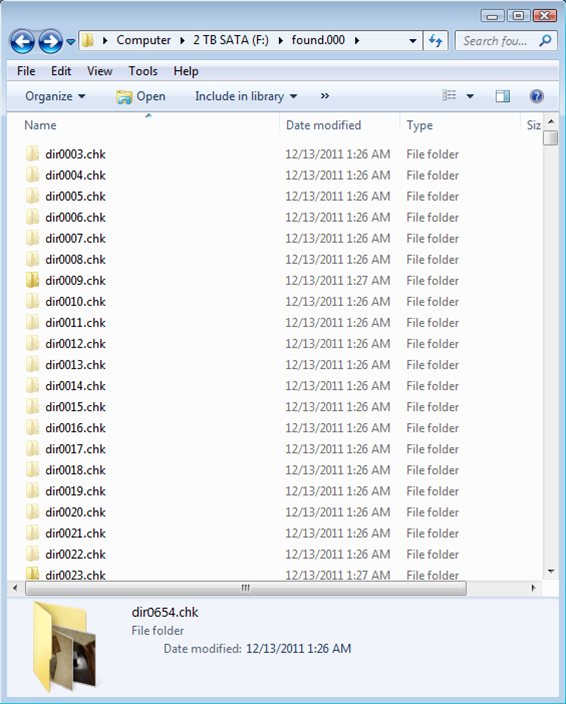Files missing after chkdsk in Windows 7
Posted on Dec 14, 2011 by
Paul WhiteIf you are reading, then its likely that you recently ran chkdsk ( check disk ) and after it was done you found that many of your files were missing. Recently my computer told me to run chkdsk because there were problems with my 2TB
SATA hard drive. Afterwards many of my files were missing. However don't worry, most of your files are still there, and I am going to help you find them.
First a little background on chkdsk
What does chkdsk do?
Your hard drive is broken into 2 sections MFT ( Master File Table ) and your data. The Master File Table tells your operating system what files are on the disk, and what sectors on the hard drive they are located. When for one reason or another, your data becomes corrupt, you may have trouble reading files, or the hard drive becomes slow as it keeps hitting bad sectors. chkdsk attempts to correct these problems. For
Hard Drives that are very large in size with many corruption errors, it may take hours or even days for chkdsk to finish.
After running chkdsk my files are missing
In my experience corruption errors are when the MFT looses track of what directories a file is supposed to be placed under. Think of it like a relational database ( SQL or
MySQL ). You might have multiple tables which are tied together with keys. If you loose track of what parent key an element is supposed to be part of, then you can no longer parse this data from the parent category. Most likely you are browsing your Hard Drive and finding that directories that once had your files, are now empty.
How to find your recovered files after chkdsk
This is what happend to me when I ran chkdsk on my 2 TB
SATA drive that stored all my family photos, vidoes plus system backups. I ran a recovery tool, and still no data. Turns out chkdsk take all the files it could not figure out where they were supposed to go and
places them in a found.000 folder that is located on the root of your hard drive. However this is a hidden folder.
To view hidden folders you need to navigate to
MainMenu > Tools > View > Hidden files and folders
fill in the bubble for "
Show hidden files, folders, and drives".
you also need to
uncheck the box next to "
Hide protected operating system files"
After this you will see a folder called
found.000, open it
Inside you will find many folders called dir0000.chk, where the 0000 is a accending number.
Each of these folders contain groups of files that were recovered.

Not 100% of your data might be there. But most of it should be there.
Now you have to drag and drop all these files into their correct destinations.
In my case I had 702 directories I was going to have to sort through.
After this I am considering setting up a SAN on my home network. After all storing all your precious memories on a single 2TB disk is not the smartest thing to do.
37613 Visitors
37613 Views
 WhiteSites Blog
WhiteSites Blog

What to do if I can't open the found.000? It just says "Access denied" -I am logged in as admin -the hard drive has permission "Full access" set to everyone -I can't change the folder's attributes or ownership or even do that "Auditing" thing(results "Access denied" again) I never had problems like this with WinXP...